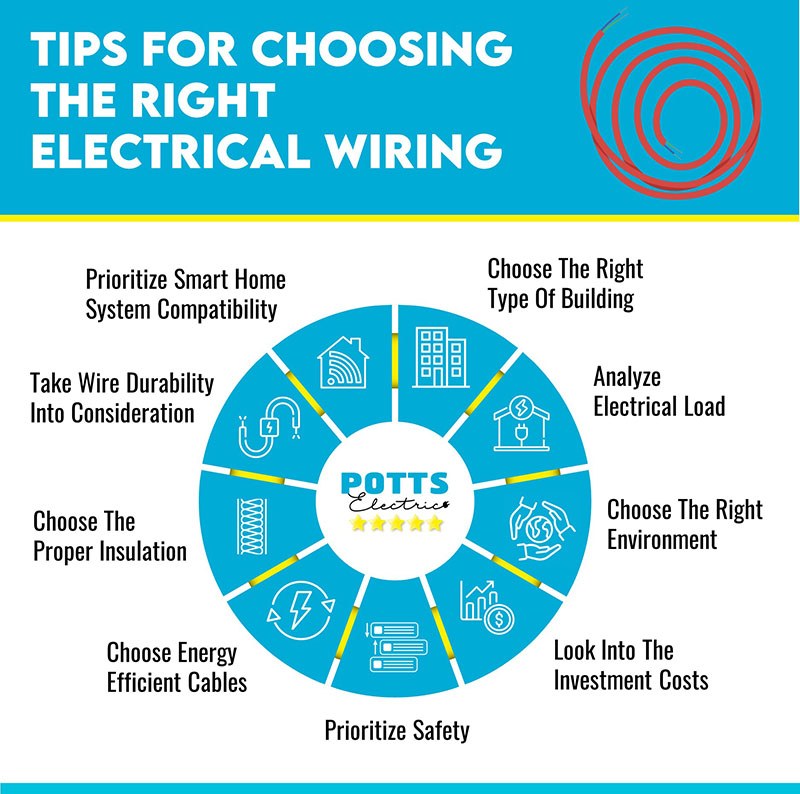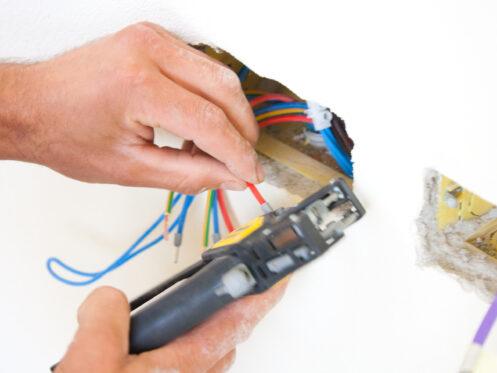More homeowners are embracing smart home devices. From blinds that open at a set time to TVs connected to the internet, it is easy to see why smart homes are becoming so popular. While most of these smart systems are remote-controlled, traditional electric wiring is still needed. Discover more about how to choose the right type of electrical wiring when you’re integrating smart technology into your home.
Types of Electrical Wiring
You can choose from different types of electrical wiring for your smart home. Here are some of the most common types.
1. Non-Metallic Sheathed Cable
Non-metallic sheathed cables have live and neutral wires enclosed with a plastic sheath. They are flexible, making them easy to install and move through walls or ceilings without needing more protective enclosures. The non-metallic sheath gives insulation. This reduces the risk of fire hazards or electrocution.
2. Coaxial Cable
Most TV and internet signals can be transmitted via coaxial cables with minimal interference. They have a shielded inner conductor surrounded by an insulator and grounded metal sleeve. Its concentric construction prevents distorted signal reception even in above-ground runs, making them better than ordinary wires.
3. Underground Feeder Cable
These are mainly used to extend connections to devices outside the house. They are durable and can remain buried in the ground without degradation. They have wet-resistance insulation to keep them safe from water in the soil. In the market, you can find two underground feeder cables: UF and underground feeder and branch circuits (UF-B). UF cables are standard, while UF-B cables are bigger and more durable. They also have higher thermal resistance levels than UF cables.
4. Individual Wires in Conduit
Individual THHN or THWN wires run separately through a conduit. The thermostat insulation can withstand moisture and high temperatures. You identify hot, neutral and ground wires based on the color of the sheath. They are mainly used when sheathed cables are inadequate.
5. Low-Voltage Wiring
Low-voltage electrical wiring serves specialized purposes in smart homes. This includes networking thermostats, doorbells and security systems that only need milliamps of current. Even though they have a small diameter, low-voltage wire insulation meets safety codes and safely routes 5-24V DC signals via walls and ceilings. They can be installed alongside standard 120-240V power wiring.
6. Armored Cables
The electrical conductors in armored cables are enclosed in a metallic wrap. You can use them in exposed areas such as outdoor structures. The metallic casing is strong and keeps the wire safe from damage by pests, harsh weather or mechanical damages.
Tips for Choosing the Right Electrical Wiring
1. Type of Building
Residential buildings have electrical codes and installation requirements that differ from commercial buildings. Consider whether conduit or armored cables meet your dwelling’s standards. You should verify if building rules allow for sufficient capacity upgrades to handle EV charging stations and automation technologies. Consulting local codes and restrictions will help you avoid costly rework. Ensure you choose wiring compliant with your building type’s electrical rules before the start of the installation process.

2. Electrical Load
The electrical load from all connected devices dictates the conductor size and number of wires required in smart home wiring. Insufficient wire gauge or too few lines will overload from lighting, outlets, appliances and automation gear. Consider total watt draw, voltage drop over distance and possible surges from compressors or motors. Ensure you allow capacity for expansions in the future. Properly assessing these collective power needs before installation prevents tripped breakers and potential fires. They also enable seamless integration of new tech additions later.
3. Environment
The area where the house needs new electrical wiring will affect materials selection. Moist basements, dusty attics and workshops with corrosive substances require insulation that’s resistant to those conditions to avoid hazards. Verify if wire coatings meet requirements when electric wires are near pools, sprinklers or high humidity due to the risk of water exposure. Specifying components rated for the actual installation environment prevents degradation issues in the future.
4. Investment Costs
Budget plays a significant role in prioritizing smart home wiring decisions. The investment costs go beyond the purchase price of electrical wires. You must consider the installation process, potential renovation and maintenance and repair fees. Minimal wire gauges can save some money initially, but upgrading the electrical system to accommodate automation systems and EV charging may be expensive. Consider the wiring value, sustainability and performance needs when planning a budget.
5. Prioritize Safety
Prioritizing occupant protection shapes every smart home wiring decision. Selected conductors, connections and components must handle maximum fault currents while eliminating fire and shock risks. Be on the lookout for outdated systems struggling to support new appliances and devices on the internet connection. You can upgrade electrical infrastructure to handle higher loads safely and effectively.
6. Energy Efficiency
Optimizing energy efficiency starts with the quality of electrical wiring. Smart home systems minimize consumption through connected lighting, thermostats, detectors and power strips designed to adapt to usage patterns. Choose cables permitting ample connectivity bandwidth to collect granular analytics from different devices.
7. Type of Insulation
There are different insulation types for electrical wires. PVC coatings are used indoors where conditions remain dry. Choose cross-linked polyethylene (XLPE) for improved heat or resistance. Underground-rated UF-B insulation withstands direct soil contact without deterioration. Consider current atmosphere exposures and future renovations like bath expansions or landscaping digs that could alter wire routes. Specifying the proper insulation from the start prevents short circuits and current leakage down the road as spaces evolve.
8. Wire Durability
Lifespan factors broadly impact smart home wiring decisions and budgets for years. Judge longevity by insulation materials, conductor metal quality and connections resisting corrosion or fatigue. You can get upgraded main panels or thicker wiring, which can endure changing electric loads for several years. There are newer fire-resistance conduits that prevent premature replacement in case regulatory codes phase outdated materials out. If you are installing wiring that will demand wall demolition in the future, then it’s wiser to choose durable systems. These should be reliable for several years to reduce disruptive renovations.
9. Compatibility With Smart Home Systems
Seamless smart home functionality depends on underlying wiring capabilities. Before installation, verify that conductors support the required communication protocols like Z-Wave, Zigbee, and WiFi for switches, sensors and controllers. Ensure adequate bandwidth capacity for simultaneous data flows to prevent lags. Select panels allowing direct integration of home automation controllers and wires that meet code requirements for transmitting power and data.
Having the right electrical wiring for your smart home ensures the safety and efficiency of your systems. If you are unsure how to pick the correct wiring for your home, seek guidance from professionals at Potts Electric. We serve residents in Ellisville and the surrounding areas. Our company deals with electric panels, EV charging and generators. Contact Potts Electric today for reliable electrical services.
